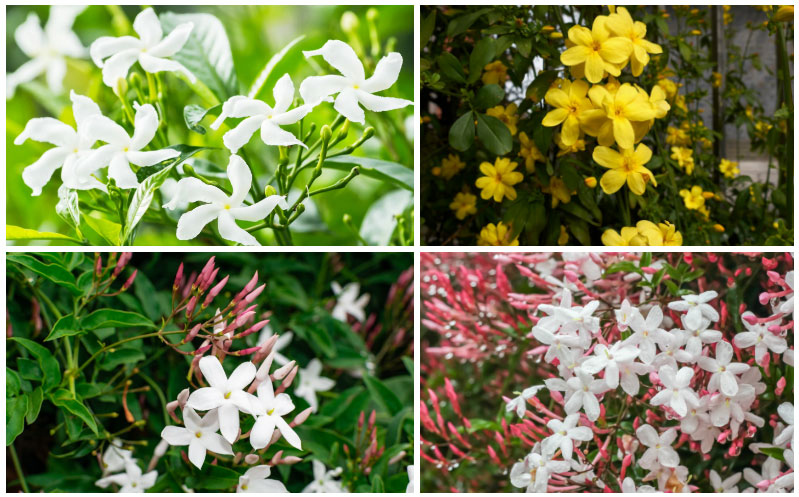Jasmine plants are known for their sweet scent and beautiful flowers. There are many types of jasmine, each with its own unique look and fragrance.
These plants are great for both new and experienced gardeners. In this article, we’ll explore different types of jasmine plants. You’ll learn about their special features and how to care for them.
Jasmine is perfect for adding beauty and fragrance to your garden. Let’s find out more about these wonderful plants.
So now that we know how amazing jasmine flowers are, would you not be excited to check out 20 similar flowers so that you have plenty of options to choose from?
Let us Begin!
1. The Regular Jasmine
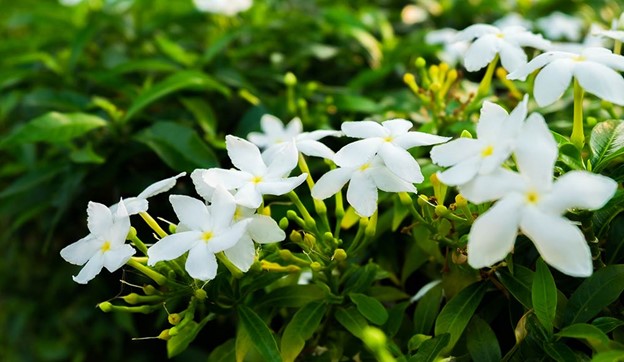
- Name: Regular Jasmine.
- Significance: National flower of Pakistan; common in the Indian sub-continent.
- Appearance: White flowers with glossy green leaves; flowers in clusters.
- Size: Grows 18 to 30 feet tall.
- Bloom Period: Flowers from June to November.
- Soil Requirements: Prefers well-drained, moderately sandy, and partially loamy soil.
- Spacing: Needs at least 8 feet of space from other plants.
2. Winter Jasmines

- Name: Winter Jasmines.
- Color and Appearance: Yellow flowers; grey stems in winter.
- Fragrance: Lacks typical jasmine scent.
- Family: Part of the olive family; vine growth.
- Size: Naturally 4 to 7 feet tall; can grow up to 15 feet with support.
- Origin: Native to China.
- Bloom Period: Flowers in late winter; ideal planting time is spring.
- Unique Trait: Flowers appear before leaves.
3. Arabian Jasmine
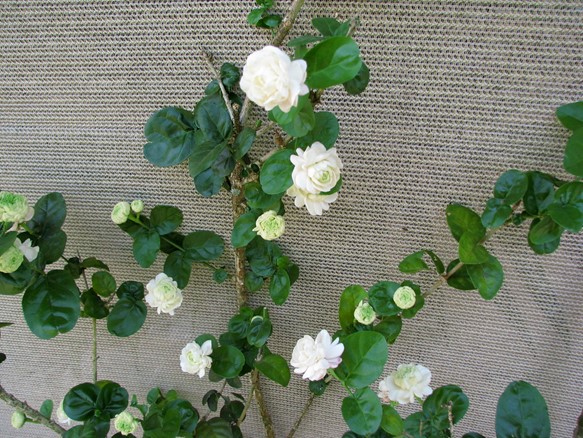
- Name: Arabian Jasmine.
- Popularity: Highly popular in Southeast Asia; known for its enchanting fragrance.
- Usage: Used in welcome garlands in Hawaii; prominent in perfumes and scented teas.
- Significance: It is the national plant of the Philippines and one of the three national plants of Indonesia.
- Appearance: Tiny white flowers growing in groups of 2-5 from each node, surrounded by glossy dark green leaves.
- Growth Style: Can be grown as a trail or an upward-growing vine with support.
- Sub-Variety: Includes a special type, “Arabian Nights,” known for its night-time fragrance.
4. Royal Jasmine

- Name: Royal Jasmine.
- Characteristics: Known for its beauty and mild fragrance.
- Appearance: Larger flowers than regular jasmine, velvety texture, white color with 5 petals.
- Flower Structure: Flat and open-faced with a downward curve; grows in clusters.
- Leaves: Light greenish shade with a waxy texture.
- Size: Grows 5 to 8 feet tall.
- Appeal: Popular for its royal-looking flowers, different from smaller jasmine varieties.
5. Dwarf Jasmine

- Name: Dwarf Jasmine.
- Key Feature: Notable for its small size.
- Maximum Growth: Limited to 1 foot in height and 2.5 feet in width.
- Appearance: Evergreen shrubs with trumpet-shaped flowers; usually in clumps.
- Flower Color: Unique among jasmines for its tiny yellow flowers.
- Fragrance: Has a pleasant smell.
- Blooming Season: Flowers in summer and fade in winter.
- Climate Adaptation: Not suitable for cold winters; best planted in spring or late winter.
- Use: Commonly utilized in bouquets and topiary designs.
6. Pink Jasmine

- Name: Pink Jasmine.
- Distinctive Trait: Known for pink-white flowers.
- Flower Color: Light pink hue noticeable upon close examination.
- Popularity: Highly favored for its low-maintenance nature.
- Growth Type: Evergreen shrubs forming large clusters.
- Leaf Appearance: Dark green with a waxy texture; dual-shaded.
- Climate Suitability: Thrives in sunny or moderate temperatures; not cold-resistant.
- Growth Potential: Can grow up to 6 meters with proper support and care.
7. Wild Jasmine

- Name: Wild Jasmine.
- Seasonality: Commonly seen in summers and autumns.
- Appearance: Traditional white color with the usual five-petal structure.
- Fragrance: Known for its strong jasmine aroma.
- Habitat: Popular in regions like South Africa and the UK.
- Resilience: Sturdy and capable of withstanding harsh weather.
- Winter Hardiness: Unlike most jasmines, can endure winter conditions.
- Growth Environment: Can thrive in a greenhouse or conservatory during frost.
- Additional Aspects: Produces fruits that turn from green to black, purely decorative; believed to provide relief from anxiety and depression.
8. Lemon-Scented Jasmine
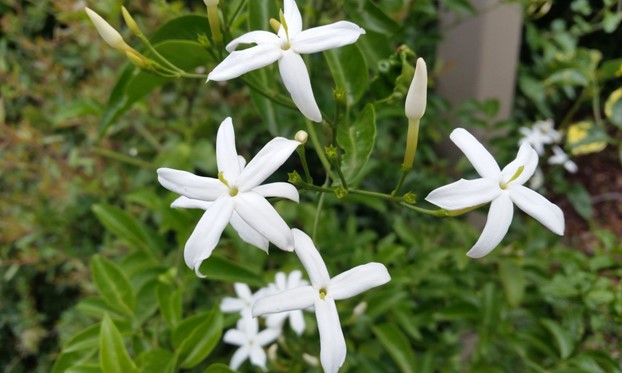
- Name: Lemon-Scented Jasmine.
- Unique Scent: Offers a refreshing lemon-like fragrance.
- Appearance: Bright white, star-shaped flowers with a pink center.
- Origin: Native to Madeira, a Portuguese island.
- Conservation Status: Considered critically endangered with few plants remaining.
- Growth Requirements: Best in sunny or moderate climates; avoid frost.
- Leaflets: Dark green, glossy leaves.
- Flowering Period: Known for a long blooming season.
- Rarity and Value: Highly prized for its unique scent and appearance.
9. Italian Jasmine

- Name: Italian Jasmine.
- Appearance: Notable for striking yellow flowers against shiny green leaves.
- Height: Can grow up to 15 to 20 feet.
- Origin: Native to Western China.
- Fragrance: Known for a delightful aroma attracting bees and hummingbirds.
- Use: Popular for garden decoration and house adornments.
- Seasonal Transition: Flowers turn into blackberries by autumn, attracting birds.
- Gardening Appeal: Its vibrant yellow flowers are a major attraction for gardeners.
10. Downy Jasmine
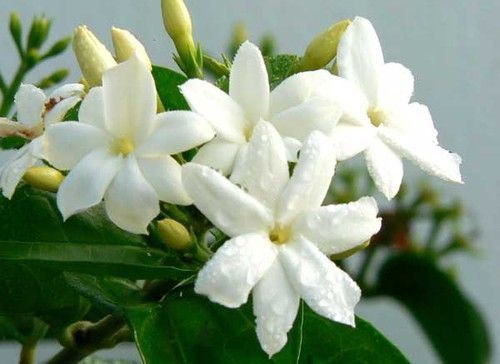
- Name: Downy Jasmine.
- Unique Feature: Lacks the typical jasmine fragrance.
- Appearance: Fresh white flowers in clumps; bright green leaves with shiny foliage and prominent veins.
- Growth: Flowers throughout the year; maintains a bushy appearance.
- Care: Requires minimal attention but needs regular trimming to maintain shape.
- Scent: Despite the lack of traditional jasmine fragrance, it adds aesthetic appeal.
- Growth Behavior: Without trimming, can spread branches widely.
11. Coral Jasmine
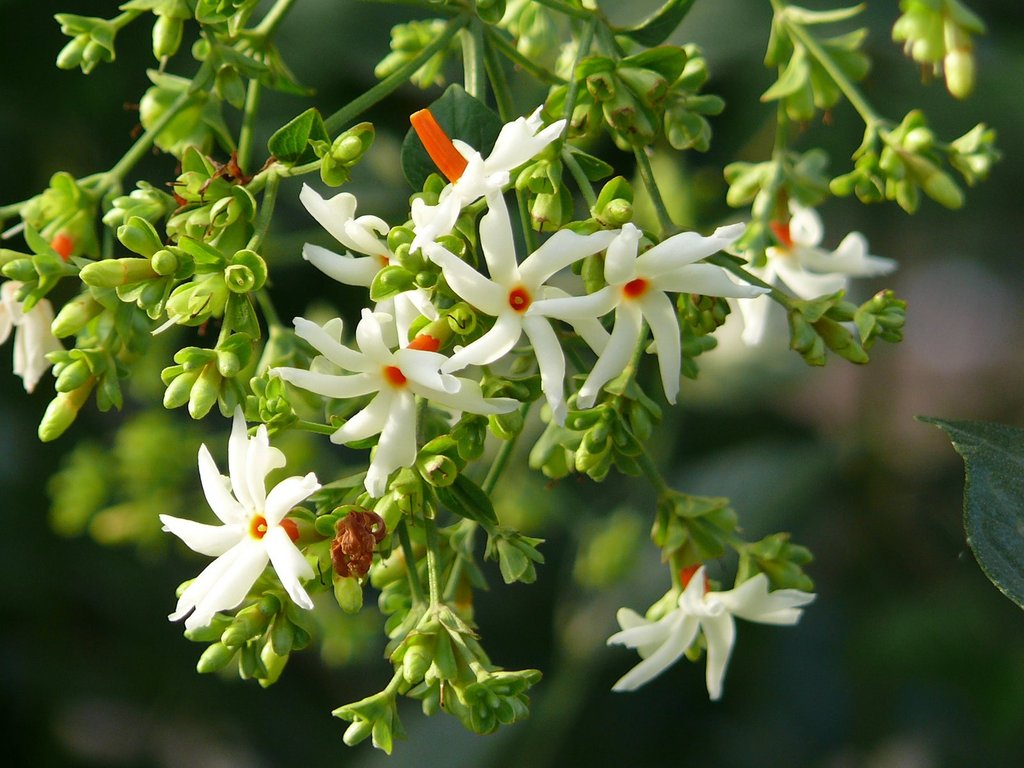
- Name: Coral Jasmine, also known as Parijat.
- Blooming Pattern: Unique for being a night-blooming variety.
- Cultural Significance: Found in South Asia, especially revered in regions like Jammu and Kashmir, Bengal, Tripura, and Thailand.
- Nicknames: Known as “tree of sorrow” due to its nocturnal blooming.
- Growth Habit: Woody perennial shrub, can grow up to 33 feet.
- Environment: Thrives in dry hilly areas and deciduous forests.
- Appearance: Flowers grow in clusters at stem tips, turning from white to flat brown seeds.
12. Star Jasmine

- Name: Star Jasmine.
- Aesthetic Appeal: Adds glamour to gardens with its star-like flower shape.
- Color: Classic white blooms arranged in a pinwheel pattern.
- Fragrance: Characteristic pleasant perfume.
- Habitat: Common in regions like China, Japan, California, and the US.
- Growth Process: Takes time to establish but offers regular blooms in summer and spring.
- Shade Tolerance: Grows best in partial shade, but can tolerate extreme shade.
- Resilience: Strong and sturdy, resistant to insect attacks.
13. Primerose Jasmine
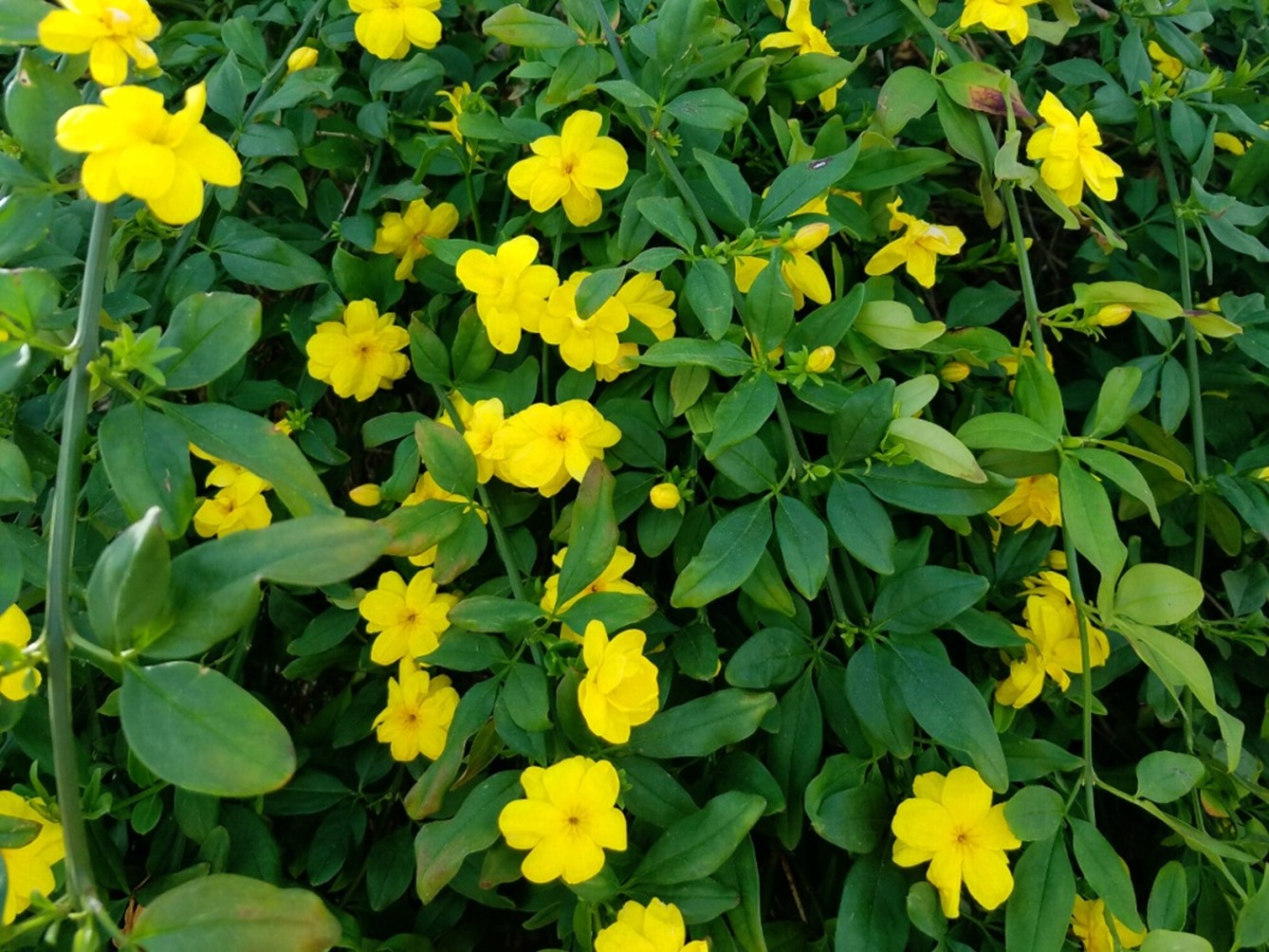
- Name: Primrose Jasmine, also known as Japanese Jasmine.
- Appearance: Cascading bunches of beautiful yellow flowers.
- Size: Grows up to 10 feet tall.
- Origin: Native to regions like Vietnam, Southern China, and Japan.
- Petal Structure: Unique with 6 petals per flower.
- Leaf Arrangement: Leaves grow in clusters of three.
- Pruning: Blooms on old wood; pruning in early summer is recommended for spring blooms.
- Wildlife Attraction: Birds often nest in these plants during spring.
14. Florida Jasmine

- Name: Florida Jasmine, also known as Showy Jasmine.
- Foliage: Characterized by shiny blue-green leaves.
- Flowers: Produces tiny yellow flowers with a sweet fragrance.
- Stem Color: Green stems turn reddish-brown as they mature.
- Blooming Season: Flowers mainly in summer and spring.
- Climate Adaptation: Not very tolerant of cold winters.
- Growth Style: Can be trimmed into a neat shrub or allowed to sprawl naturally.
- Watering Needs: Drought resistant; requires occasional watering in hot weather.
15. Stiff Jasmine
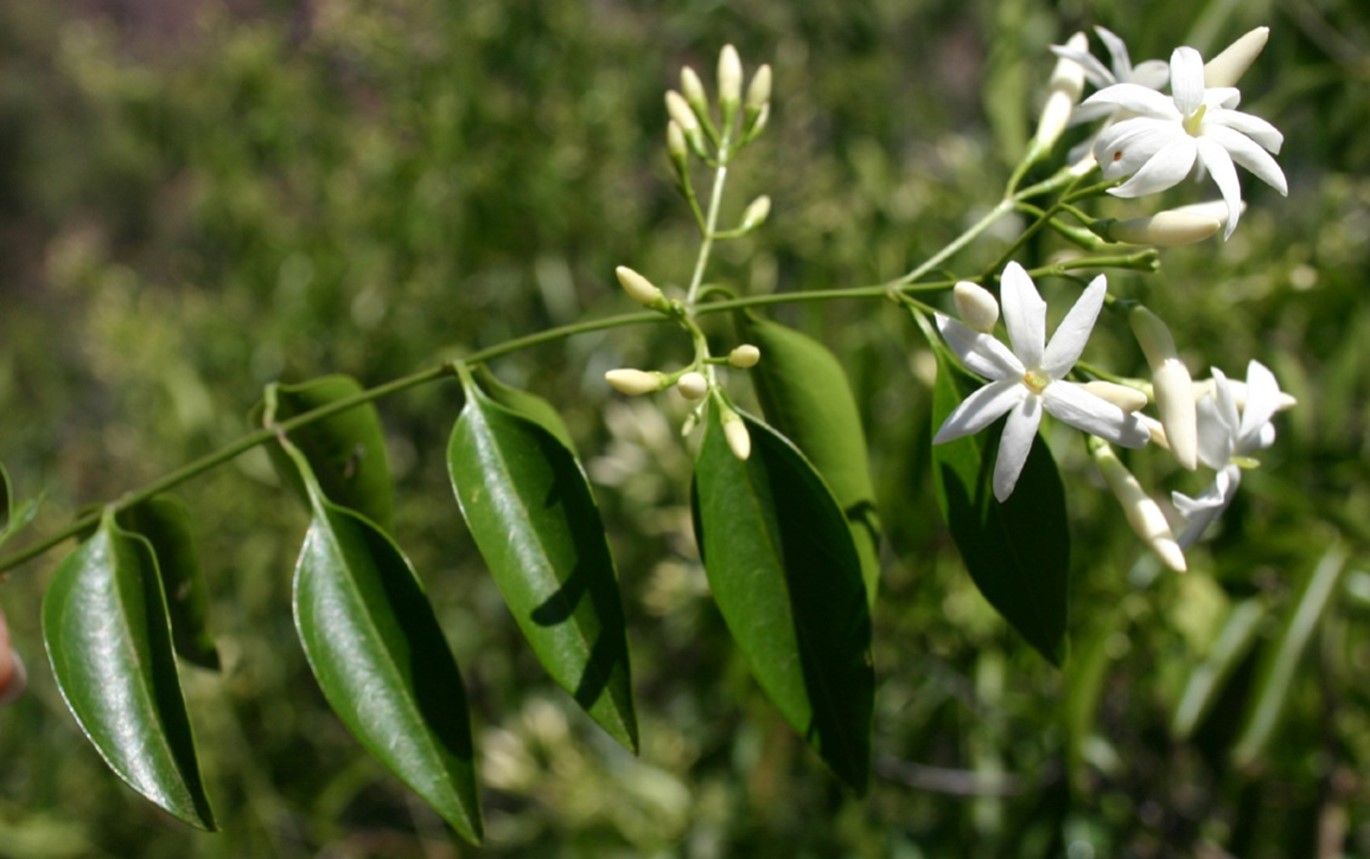
- Name: Stiff Jasmine.
- Origin: Native to Australia.
- Family: Belongs to the olive plant family.
- Growth: Grows 2 to 4 feet tall; can climb up to 10 feet with support.
- Stem Characteristics: Smooth, green, and hairless.
- Leaves: Shiny green with an oval shape.
- Flowers: White colored, typically blooms in winter.
- Fruit: Produces shiny blackberries, not edible for humans.
16. Night Blooming Jasmine
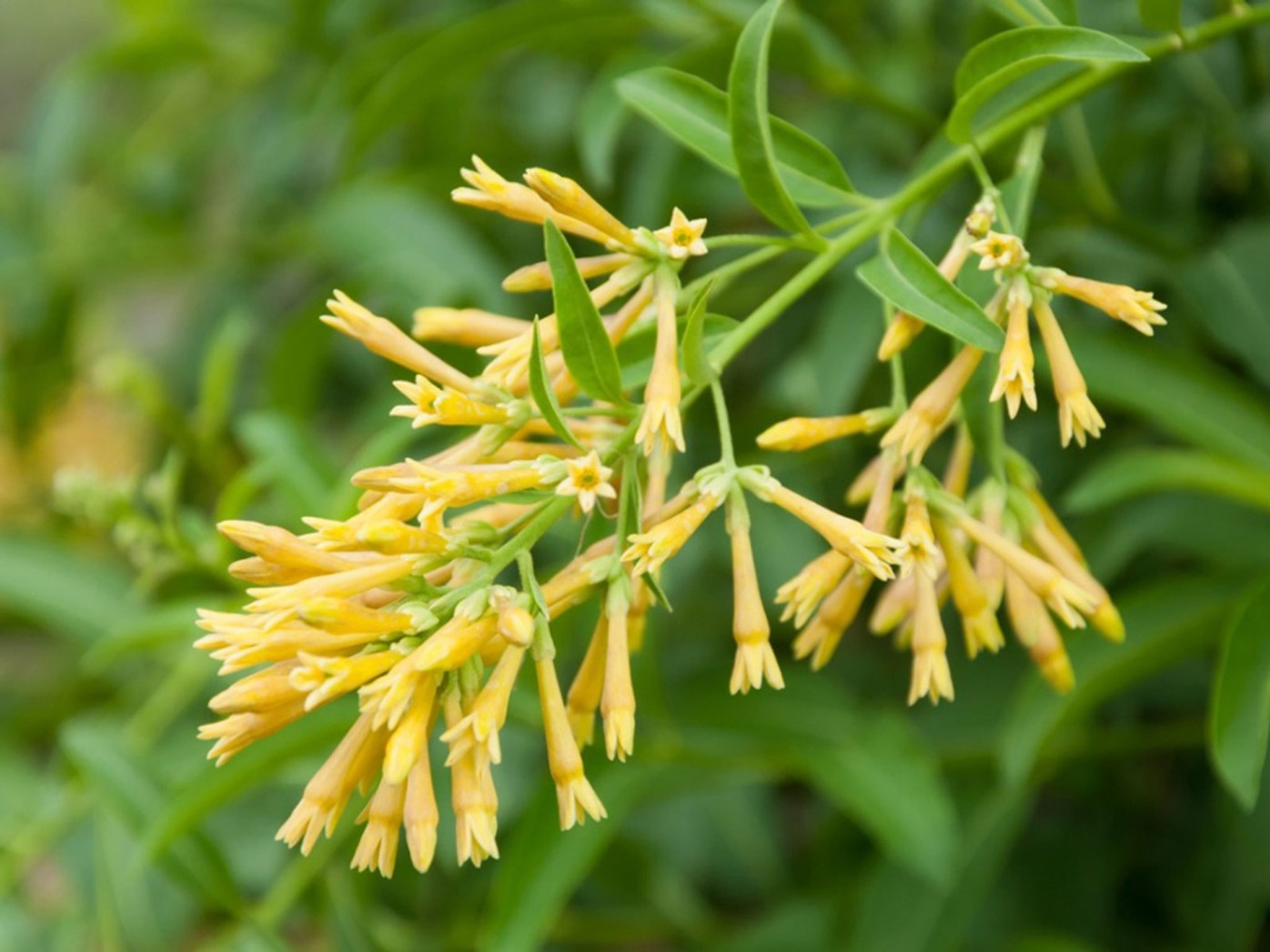
- Name: Night Blooming Jasmine.
- Ideal for Screening: Excellent choice for creating natural screens in gardens.
- Growth: Reaches 8 to 10 feet in height and about 3 feet in width.
- Structure: Columnar shape.
- Flowers: White tubular flowers bloom in summer and spring.
- Fruit: Produces small white fruits attracting bees and birds.
- Unique Feature: Opens at night, releasing a heavenly fragrance.
- Visual Appeal: Simple in appearance but highly valued for its nocturnal scent.
17. Cape Jasmine

- Name: Cape Jasmine.
- Distinct Look: Resembles a white rose more than a traditional jasmine flower.
- Leaf Characteristics: Shiny lance-shaped green leaves.
- Award: Received the “Award of Garden Merit.”
- Fragrance: Pleasant and delicate scent.
- Bloom: Flowers throughout the year in warm climates; late spring or early summer in cooler regions.
- Origin: Native to southern China and Japan.
- Sunlight Needs: Prefers full sun but requires partial shade in winter.
Conclusion
So, these were the 17 gorgeous varieties of jasmine flowers that you must check out.
We know that choosing one or two flowers from this extensive variety is difficult, but the best part about these flowers is no matter what you choose, you can be assured of getting the best because all these jasmine flowers are equally beautiful and easy to take care of.
You must check which suits your needs and climate are the best. We hope this article was helpful and all your doubts were cleared.
If you have any further queries, feel free to contact us in the comment section below.

